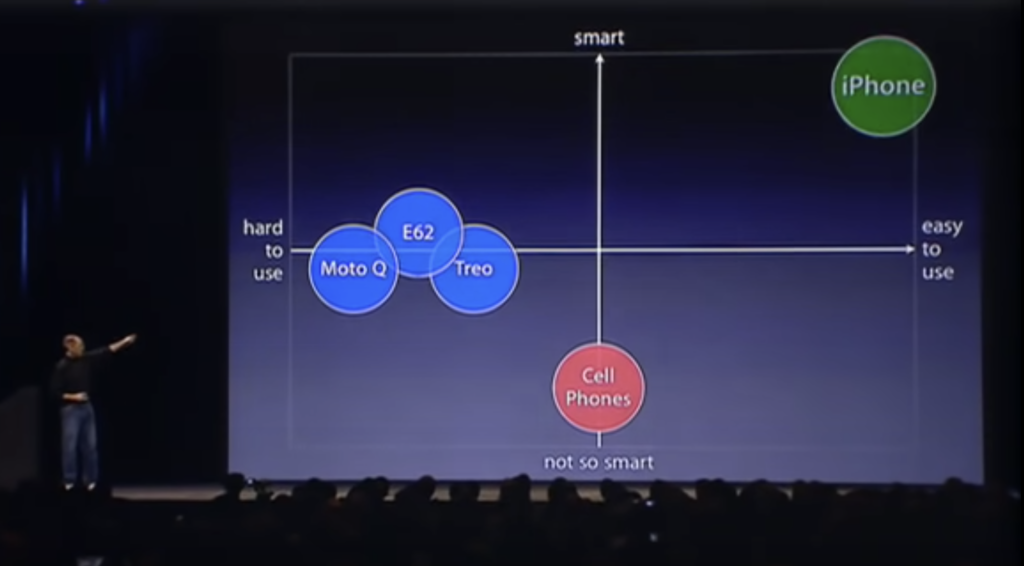
Want Your Business To Win? Become a Category Creator
iPhone didn’t beat Blackberry or Motorola.
That’s right, I said it. But before you call me a liar, let me explain why I say that.
iPhone didn’t beat Blackberry because they weren’t actually competing in the same game. Heck, they weren’t even playing the same sport.
One of the biggest reasons that Blackberry gave up its 50% US and 20% Global market share was because of a strategy called Category Creation.
iPhone became a Category Creator. For this to make sense, we need to first look at the problem that each of these products were solving and how they communicated it to the world.
What Is A Category Creator?
One of the biggest reasons iPhone was able to de-throne Blackberry was because it created a brand-new category. This is what the authors of Play Bigger define as a Category Creator. A Category Creator decides to go out into the world and create something brand new that’s in a category of their own.
See, a Category Creator doesn’t need to be the first product to market – often called First Mover Advantage.
The secret to category creation is that you position your company, its messaging, and its purpose to an area with no competition.
There are three key activities that any company that wants to become a Category Creator needs to do and do for the entire life of the company:
- Choose a different problem (preferably one that no one else is)
- Position yourself as THE company that is solving THIS problem
- Hijack the conversation and tell everyone that you’re the ONLY sheriff in town
Let’s explore what this looks like in action using the Blackberry v. iPhone duel as a marketing history lesson.

Choose A Different Problem To Solve
The first thing that anyone looking to be a Category Creator must do is position themselves into Blue Ocean market. What that means is to avoid markets where there’s a lot of competition for a limited number of customers. A Red Ocean is a bloody metophor for all the carnage that you’ll be joining if you choose to join the feeding frenzy.
A Blue Ocean on the otherhand is clear of others and appears to be limitless.
A question to ask yourself when choosing a market is “Who are my competitors?”. If you can confidently say “no-one”, then you’re on the right track to becoming a Category Creator.
RIM was way ahead of Apple to getting a smartphone to market. There were dozens of players already in the space also.
Despite Blackberry already having most of the market, and Apple needing to come in late to the smartphone party, how were they able to pull off such a huge takeover in such a short time? What opportunity did Apple see to enter a seemingly crowded space?
The answer: Apple defined a different problem than the other phone manufacturers.
To see the differences, let’s take a closer look at the problems that Blackberry and iPhone solve.

a business tool for business people
A Closer Look at Blackberry
Problem: Business is hard when you’re on-the-go. Accomplishing foundational business tasks is a pain without a PC.
Solution: A business tool that allows you to securely do emails, calls, and use your calendar when you’re out of the office. Email, calls, calendar.
RIM called the Blackberry a “smartphone” because compared to the others that were available on the market, it surely was.
Their entire positioning was predicated on the fact that business happens on a Blackberry. And for many years, it did.

the need to feel connected
A Closer Look at iPhone
Problem: People want to feel connected.
Solution: A social tool that allows you to take pictures of yourself and surroundings, navigate the world around you using GPS, and share your adventures with whoever you want, however you want through countless applications. Apps, maps, selfies.
Rather than copy the same problem that Blackberry was solving, iPhone uncovered a new problem. One that was felt by more people than just business types. One that transcended language, borders, and demographics.
By choosing a different problem, Apple got to re-define what a smartphone could do, rather than copy the features of their competitors.

Position Yourself as the Leader Solving That Problem
Now that you’ve identified the problem and claimed to be the only one with the solution, it’s time to get others to agree with you and take notice.
And the best way to gain traction as a leader is to have others talk about your business.
There are many ways to get others to talk about you, from getting in the news, to posting organically, to renting the biggest billboard money can buy.
But my favourite is to find people who are already solving a small slice of a much bigger problem.
Start By Solving A Small Slice of the Massive Problem
With Apple, they recognized that if they were going to dominate the space, they needed to have the best software to match their superior hardware. So they looked to the development community.
One of the biggest problems that an independent developer faces is the need to market and distribute your software product once you’ve built it. Unfortunately, the old saying build it and they will come is just plain untrue.
Apple recognized this, and so they made iPhone solve a related problem: they made it easy for developers to bring their product to market by creating the App Store.
This strategic move began turning the Flywheel, building momentum for Apple as a Category Creator. As more developers began making apps for the iPhone, it attracted more iPhone customers. Those new customers then began telling others about how terrific the apps on the iPhone are compared to the Blackberry. This increase in users then attracted more developers to begin publishing their work on the App Store, and so on, and so on.
This Flywheel action is what propelled iPhone into the mainstream, garnering over 1.5 Billion app downloads within the first year of launching the App Store.

Find more statistics at Statista
Now that Apple had positioned iPhone as a very real solution to both the problems of developers and consumers, it was now time to dominate the conversation.
Hijack the Conversation to Own the Category
Now that you’ve got some momentum and product-market-fit, it’s time to dominate the conversation.
This step requires you to find opportunities to jump on emerging topics and trends like a surfer would ride a wave. If you’re too early, no matter how hard you’re paddling, you’ll never get the kind of speed you need. You’ll grow tired and eventually stop.
But if you can time it just right, you can ride a wave all the way into the shore faster than you could have ever swam.
Finding opportunities to hijack media of any type allows you to further deepen your positioning as a category leader. This last step is important for a few reasons:
Position Your Brand Beside the Problem
When you’re looking for ketchup, you reach for Heinz. When you want to get on a video chat, you tell someone to Zoom or Facetime you. Kleenex, Draino, and Band-Aid are all examples of Category Creators who have dominated the conversation for years. But they needed to position themselves as the best of that category, and they did so by positioning themselves beside the problem.
Write Your Own Headlines
What people perceive is their truth. And if your brand appears in 3rd party media, then they perceive you to be the real deal. What people consume in the media validates what they already think is going on.
Had Apple not made a huge deal of announcing the iPhone, it likely would have only been written about in tech magazines. Instead, they invited reporters from every major publication and media outlet. Steve Jobs practically wrote tomorrows headlines for his own product launch!
NOTE: Starting at 4:23, notice how Steve actually goes on to explain that iPhone is not a Smartphone, but rather an Internet Communications Device.
By bringing all those reporters into the room, he was able to use his master marketing and presentation skills to awe them into writing fantastic headlines, exactly the way he wanted them.
Force Your Competitor To Acknowledge You
If you’re noticing a competitor trying to encroach on your turf, lean into them and try to get mentioned in the same news article. This is a great way to hijack the media because the writer will have to describe what makes the two companies different. This is the exact time that you tell them about your new category. This is the time to plant the seed.
And if your competitor needs to name drop you, especially in a negative way, you know you’re going something right.
Because by having them acknowledge your mere existence, it’s announcing to the world that you’re different. And remember: different is what we’re going for.
Conclusion
Becoming a Category Creator isn’t for everyone.
But for those who want to pave their own path and steer clear of hustling for tiny fractions of market share, then Category Creation might just be for you.
Choose a Different Problem to Solve.
The problem should be different enough from your competitor, but not so different that it confuses people. This is both a science and an art. To learn more about identifying the Adjacent Possible, take a look at Steven Johnson’s Where Good Ideas Come From.
Position Yourself as the Leader Solving That Problem
Now that you’ve defined your point of view, do everything you can to position that problem as something serious that needs to be solved. Talk to those who are close to the problem. Find others who have a similar problem and rope them in too. Make the problem known by everyone.
Dominate The Conversation
Now comes the time to dominate the conversation. Make it easy for people to love or hate you. Either way is good because once media grabs onto your problem and position, it becomes real to those who consume that media. This spreads your message faster than you ever could on your own. Ride that wave all the way into the beach.
Want A Masterclass in Category Creation?
Mike Damphousse and Kevin Maney are two of the best Category Designers in the biz. I had the pleasure of speaking with them on an episodes of the podcast Top Of Mind with Stewart Hillhouse.
On the show, we get into detail about:
- How anyone can think like a Category Creator
- The three variables of the Category Creation Formula your need to know before you start creating a category
- What are some of their favourite categories that are emerging
- And so much more!
Be sure to check out Play Bigger, the book that inspired this post that Kevin Maney co-authored.


